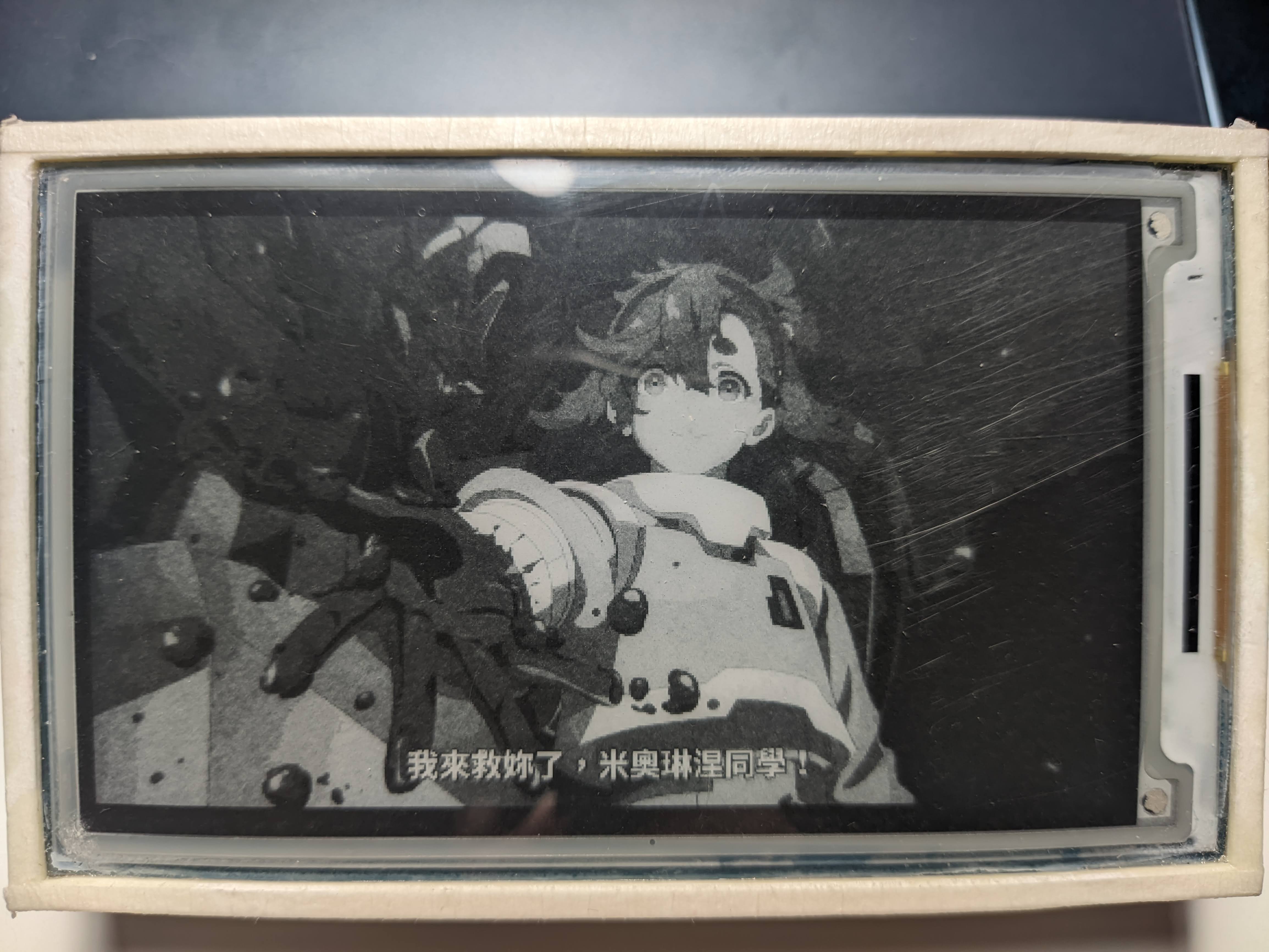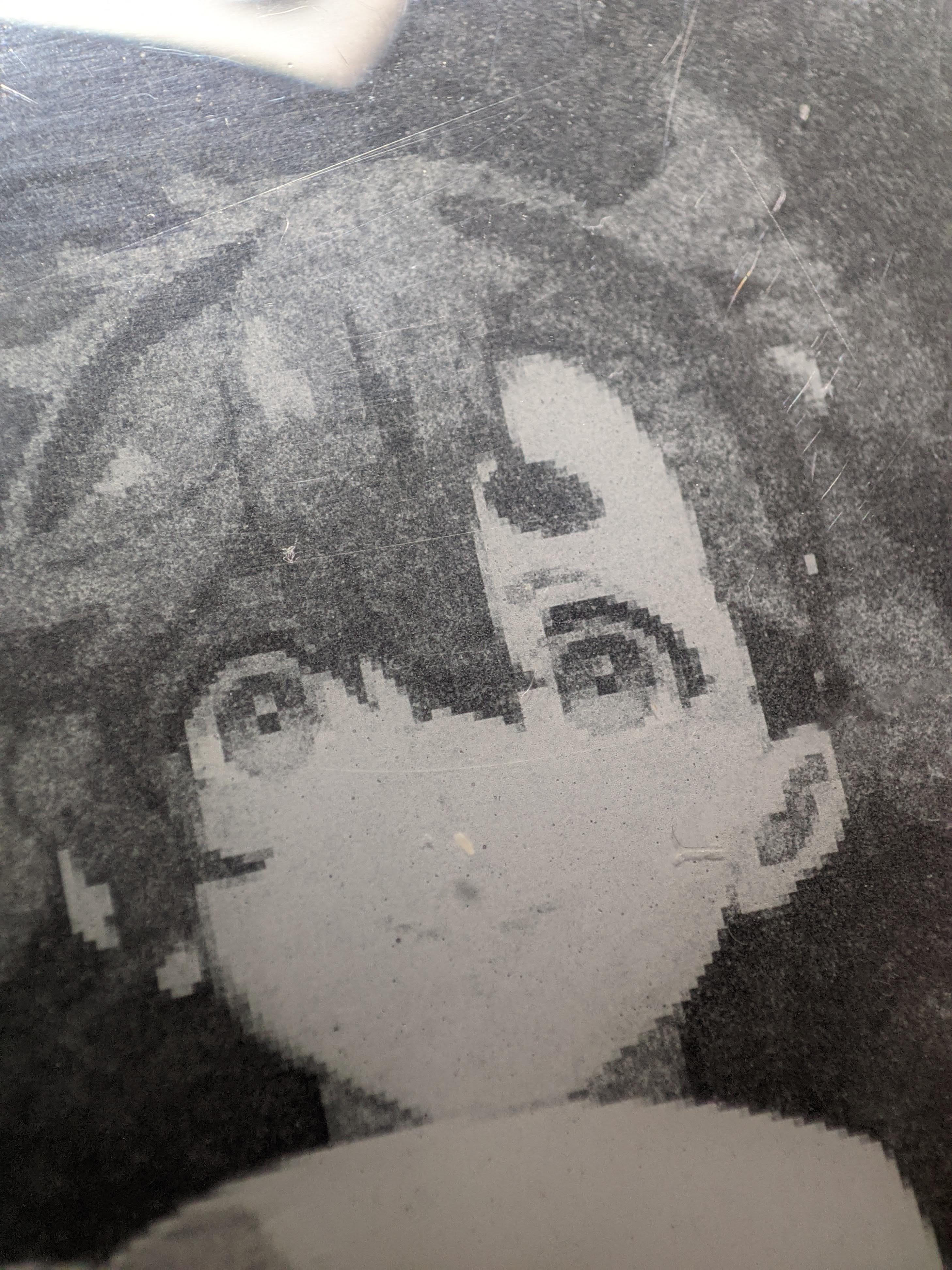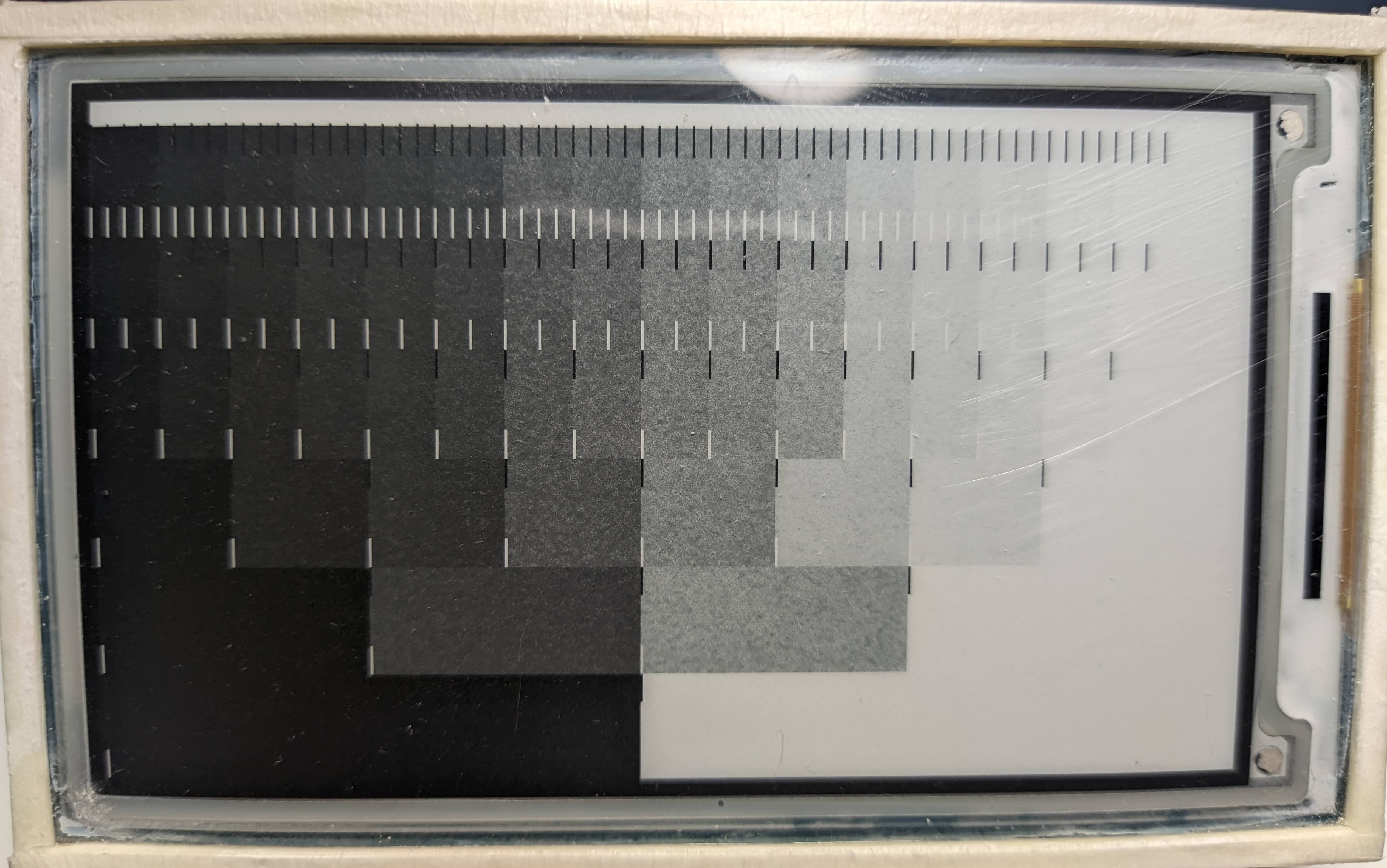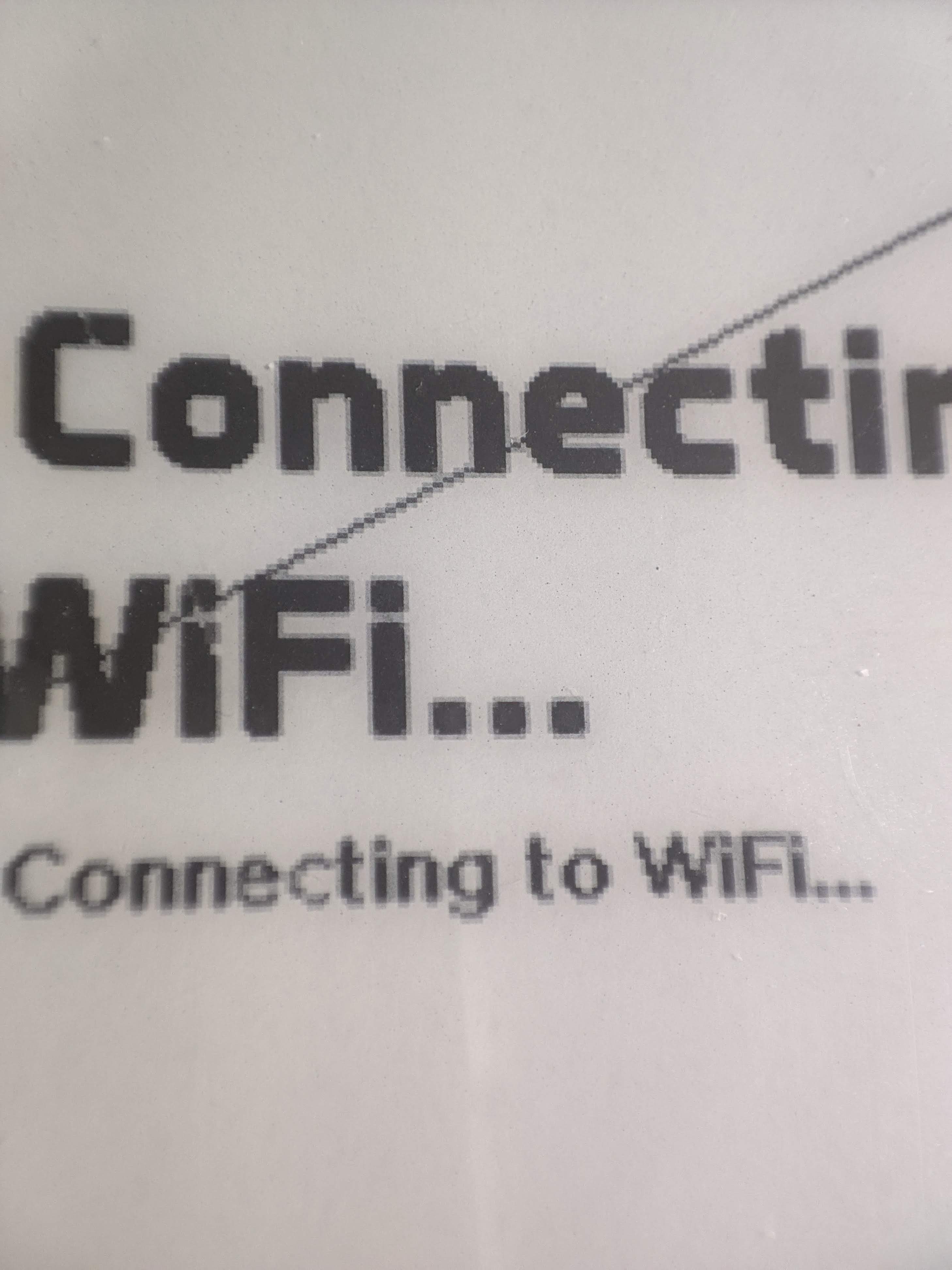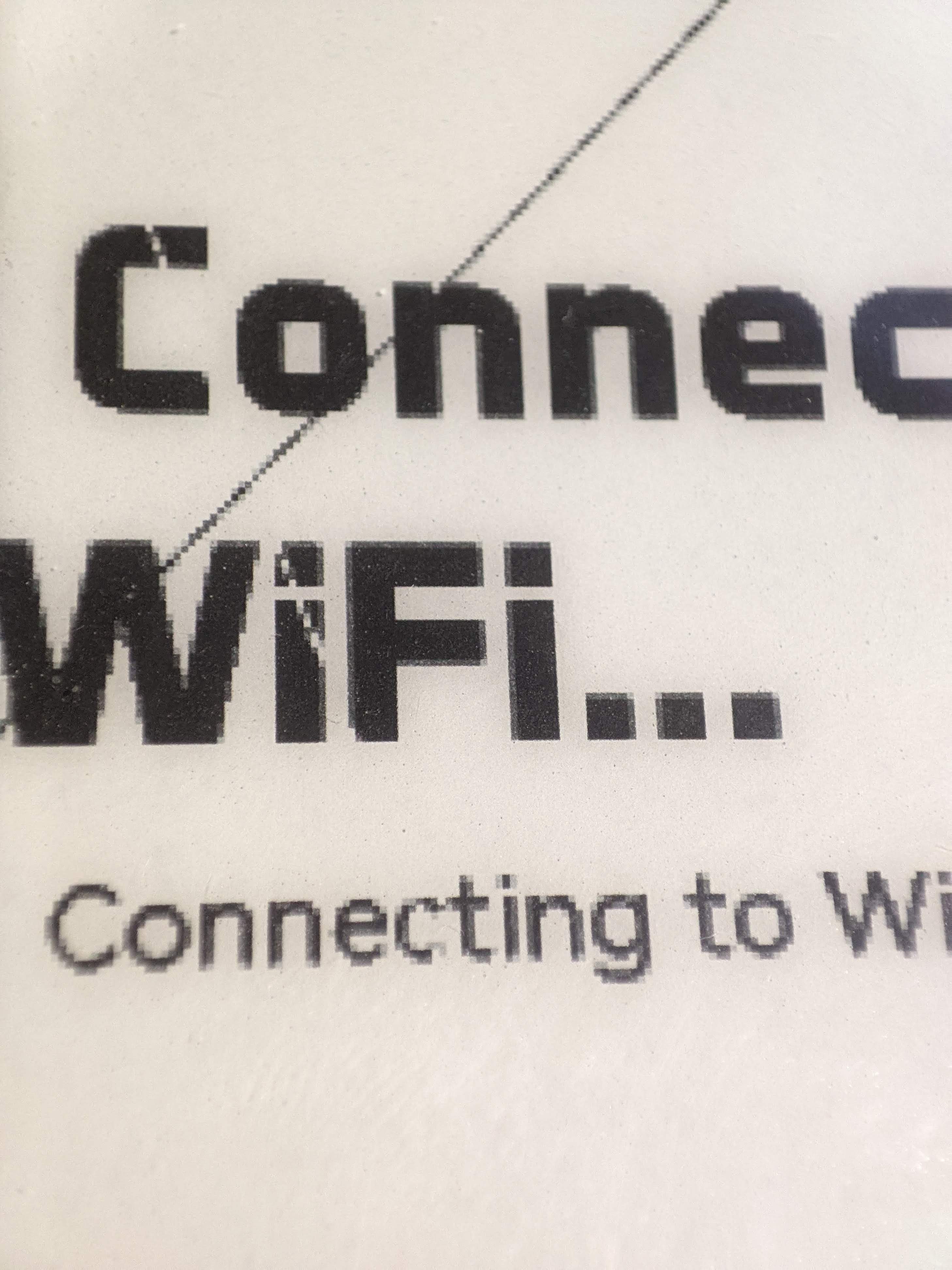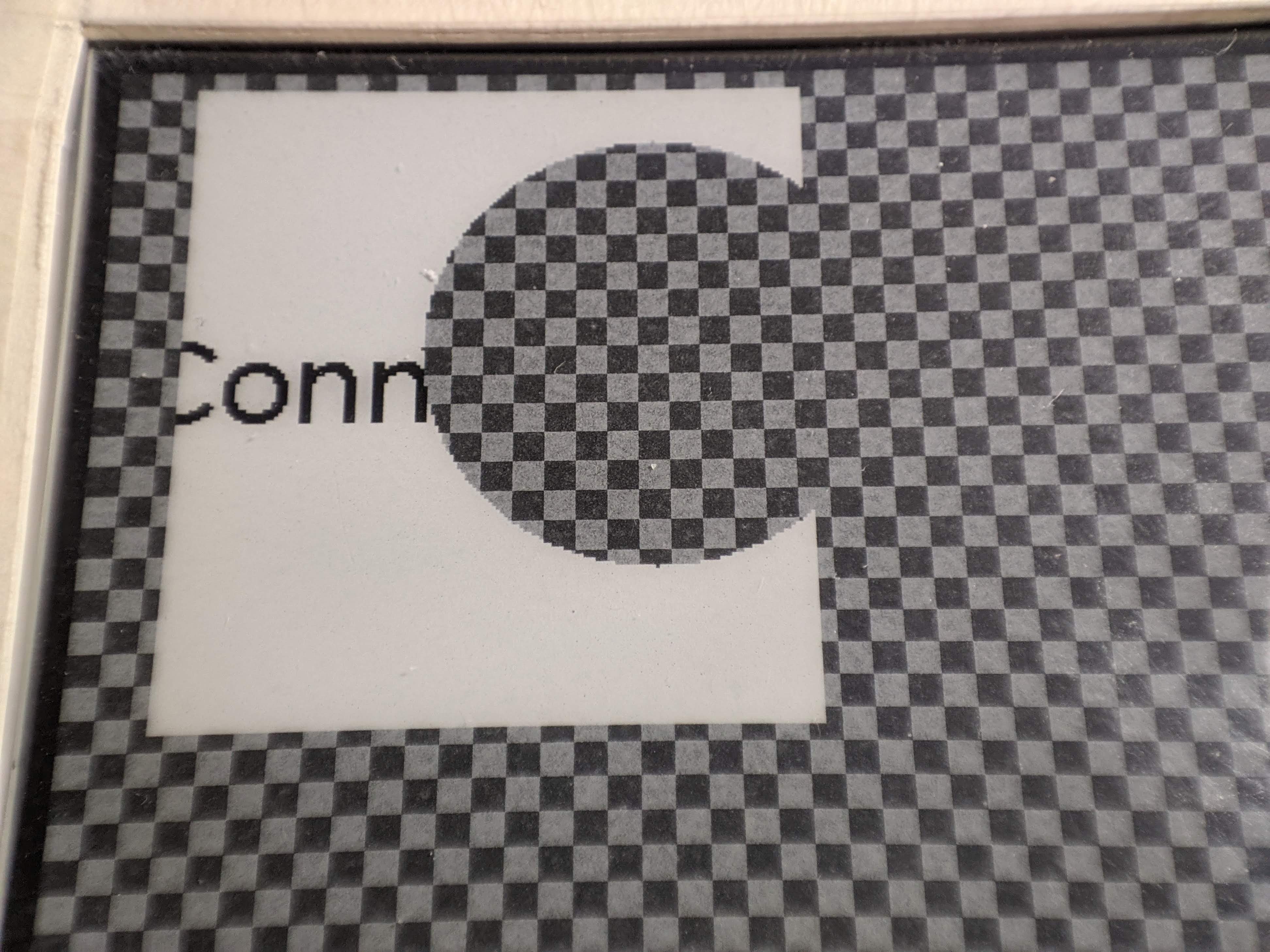An ePaper display library with endless possibilities
currently only supports Waveshare 3.7" ePaper HAT
Like... draw stuff in 480*280 hIgH rEsOlUtIoN 4-bit 16 color wIdE cOlOr gAMut on your 4-shades-of-grey-capable ePaper display?
source: MS Gundam - The Witch from Mercury
This library is not done, and so does this README. It's a mess, and information may be incorrect.
This is drawn with the EpGreyscaleDisplay function with the display mode GC16. It uses 3 update cycles to create 64 different "brightening" durations after
wiping the screen black. Then from which 16 colors that most represents a greyscale are picked (manually, by eye). It can technically be done in 2 display
cycles, but due to the nature of the ePaper chemistry (idk), "brightening" one unit of time from black will create a far bigger brightness difference than the
difference between 62 units and 63 units.
const uint8_t EpGreyscaleDisplay::lut_64_to_16[] = {0, 1, 2, 3, 4, 5, 7, 9, 11, 13, 15, 23, 27, 31, 53, 63};This is the lookup table I ended up using. dYou might see why doing in 2 cycles won't work as well as this does.
Also, since the black capsules are "barely below white" through this process, after a few display updates, the blacks tend to fade away (not that much though,
don't worry, and it is after 40 partial updates). Even though I set VCOM voltage to 0 (so DCVCOM = VSS, so no voltage difference at all), it still does that.
Starting from grey and do brightening and darkening at the same time is another option. The video below is done this way in 2 display cycles. But this method
does not guarantee strictly increasing brightness, especially that the environment temperature can quite heavily affect the display, I think this is a better
option.
Partial update with masks is also implemented. Here's a demo:
16grey_partial_small.mp4
(Converted oversize video with VLC, came out stretched, whatever)
{ /// draw greyscale background
// clear screen
EpPartialDisplay partialDisplay(epd);
gfxBuffer.fillScreen(GFX_WHITE);
partialDisplay.display(&gfxBuffer, EpPartialDisplay::DU2);
// draw rectangles
uint16_t colorCodes[4][16] = {
{0b00000000, 0b11111111},
{0b00000000, 0b01010101, 0b10101010, 0b11111111},
{0b00000000, 0b00100100, 0b01001001, 0b01101101, 0b10010010, 0b10110110, 0b11011011, 0b11111111},
{0b00000000, 0b00010001, 0b00100010, 0b00110011, 0b01000100, 0b01010101, 0b01100110, 0b01110111,
0b10001000, 0b10011001, 0b10101010, 0b10111011, 0b11001100, 0b11011101, 0b11101110, 0b11111111}
};
for (int bit = 1; bit <= 4; bit++)
for (int seg = 0; seg < (1 << bit); seg++)
gfxBuffer.fillRect((bit - 1) * (epd.EPD_WIDTH / 4), seg * (epd.EPD_HEIGHT / (1 << bit)), epd.EPD_WIDTH / depth, epd.EPD_HEIGHT / (1 << bit), colorCodes[bit - 1][seg] << 3);
// draw image using greyscaleDisplay
EpGreyscaleDisplay greyscaleDisplay(epd);
greyscaleDisplay.display(&gfxBuffer, EpGreyscaleDisplay::GC16); // greyscale clear 16
}
delay(1000);
{ /// draw overlay menu with partial display
// create a mask for partial display
EpBitmapFast updateMask(280, 480, 1);
updateMask.setBitmapShapeBlendMode(EpBitmapFast::SHAPES_ONLY); // use shapes mode to save memory space instead of bitmap
updateMask.setRectangle(10, 40, 200, 400, 0xFF, EpShape::ADD);
const char* str[20] = { // Clion File menu
"New",
"Open...",
...
"Exit"
};
gfxBuffer.fillRect(10, 40, 200, 400, GFX_WHITE);
int highlightedItem = 0;
EpPartialDisplay partialDisplay(epd);
gfxBuffer.fillRect(10, 40, 200, 400, GFX_WHITE);
// draw menu
gfxBuffer.setFont(&HarmonyOS_Sans_Medium8pt7b);
for (int f = 0; f < 20; f++) {
highlightedItem = f;
// clear previous
gfxBuffer.gfxUpdatedRegion.reset(); // reset the "bounds of updated pixels" after displaying
int i = previousHighlightedItem;
gfxBuffer.fillRect(10 + margin, 40 + margin + itemHeight * i, 200 - 2 * margin, itemHeight - 2 * margin, GFX_WHITE);
gfxBuffer.setTextColor(GFX_BLACK);
gfxBuffer.setCursor(10 + margin + 4, 40 + margin + itemHeight * i + 11);
gfxBuffer.print(str[i]);
// highlight current
i = highlightedItem;
gfxBuffer.fillRect(10 + margin, 40 + margin + itemHeight * i, 200 - 2 * margin, itemHeight - 2 * margin, GFX_BLACK);
gfxBuffer.setTextColor(GFX_WHITE);
gfxBuffer.setCursor(10 + margin + 4, 40 + margin + itemHeight * i + 11);
gfxBuffer.print(str[i]);
// display (with windowed update)
partialDisplay.display(gfxBuffer, placement, EpPartialDisplay::A2, &updateMask, nullptr, &gfxBuffer.gfxUpdatedRegion);
// we did nothing extra, just calling gfx draw functions. the region where pixels has been updated (gfxUpdatedRegion) has been determined automatically
previousHighlightedItem = highlightedItem;
}
}You can now determine an update region from Adafruit_GFX functions and then pass it to the display function. For the example above, the update time is down to 18ms! Because finding out the bounds of "updated pixels" is not always simple, or require additional logic. Check the code below to see how easy it is to implement windowed update!
[epepd] Updating region X from 8 to 208, Y from 114 to 147, that is 4% of a full frame!
[epepd] EpPartialDisplay calculate lut took 17237us
Example pulled from jrymk/pdtvtPaper
bool greyscaleRefresh = false;
EpRegion updateRegion;
EpBitmapMono partialUpdateMask(gfxBuffer.width(), gfxBuffer.height());
void refresh() {
if (greyscaleRefresh) {
greyscaleDisplay.display(&gfxBuffer, epdPlacement, EpGreyscaleDisplay::GC16);
greyscaleRefresh = false;
}
else {
partialUpdateMask.setBitmapShapeBlendMode(EpBitmap::SHAPES_ONLY);
partialDisplay.display(&gfxBuffer, epdPlacement, EpPartialDisplay::GC2_PARTIAL, &partialUpdateMask, &partialUpdateMask, &updateRegion);
}
updateRegion.reset();
partialUpdateMask.clearShapes();
gfxBuffer.gfxUpdatedRegion.reset();
}
// greyscale background
void drawBase() {
partialDisplay.clear();
gfxBuffer.fillScreen(COLOR_BACKGROUND);
gfxBuffer.fillRect(DASHBOARD_STATUS_BAR_LINE_MARGIN, DASHBOARD_STATUS_BAR_HEIGHT,
gfxBuffer.width() - 2 * DASHBOARD_STATUS_BAR_LINE_MARGIN, DASHBOARD_STATUS_BAR_LINE_THICKNESS, COLOR_SEPARATOR);
greyscaleRefresh = true;
}
// b/w datafields that can be partial updated
void updateIPAddressField() {
static EpRegion prevRegion;
// gfxUpdatedRegion should be empty now
gfxBuffer.fillRect(prevRegion.x, prevRegion.y, prevRegion.w, prevRegion.h, COLOR_BACKGROUND);
// discard the updated region from the background rect, because it is just prevRegion, and we want to know the region covering the new text only
gfxBuffer.gfxUpdatedRegion.reset();
drawText(gfxBuffer, DASHBOARD_STATUS_BAR_LINE_MARGIN + 2, DASHBOARD_STATUS_BAR_HEIGHT - 4, HALIGN_LEFT, VALIGN_BASELINE,
COLOR_BODY, &FONT_SMALL,
WiFi.localIP().toString().c_str());
// gfxUpdatedRegion includes the new text only
// add to partial update mask
partialUpdateMask.pushShape(gfxBuffer.gfxUpdatedRegion.getEpShape()); // this includes the new text
partialUpdateMask.pushShape(prevRegion.getEpShape()); // this includes the background rect for covering up
// add to update region
updateRegion.include(gfxBuffer.gfxUpdatedRegion, noPlacement); // this includes the new text
updateRegion.include(prevRegion, noPlacement); // this includes the background rect for covering up
// set prevRegion covering the new text only. doing the regions for the background and text separately is all for this
prevRegion = gfxBuffer.gfxUpdatedRegion;
// can reset after including to the global updateRegion, and allows other fields to know the smallest rect covering the updated region
gfxBuffer.gfxUpdatedRegion.reset();
}
// other fields...
Rough edges? With getPixelLUT custom transition function, you can send pixel data that are multisampled from neighbor pixels.
Yes, I know it looks terrible, especially that c... Although there's a white line that went through it.
But all you need to do is...
EpBitmap gfxBuffer(480, 280, 1); // set the Adafruit_GFX buffer
Epepd epd(gfxBuffer, EPAPER_CS, EPAPER_DC, EPAPER_RST, EPAPER_BUSY);
void setup() {
epd.init();
gfxBuffer.allocate(4096); // allocate the buffer in 4KB chunks so that it will fit in memory
// start drawing
epd.setTextColor(BLACK);
epd.setCursor(10, 100);
epd.print("Connecting to\nWiFi...");
epd.setFont(&HarmonyOS_Sans_Medium8pt7b);
epd.setCursor(10, 180);
epd.print("Connecting to WiFi...");
epd.drawLine(0, 150, 260, 9, BLACK);
epd.drawLine(0, 10, 150, 425, WHITE);
// display
epd.display();
}and for the display function override... (the actual "plugin" style classes has not been implemented yet)
void Epepd::display() {
initDisplay();
writeToDisplay([](Epepd &epepd, int16_t originX, int16_t y) {
int blackPixels = 0;
for (int dx = -1; dx <= 1; dx++)
for (int dy = -1; dy <= 1; dy++)
if (epepd.gfxBuffer->getPixel(originX + dx, y + dy)) blackPixels++;
const uint8_t defBlack[] = { LUT0, LUT0, LUT1, LUT1, LUT2, LUT2, LUT2, LUT2, LUT3, LUT3 };
const uint8_t defWhite[] = { LUT0, LUT0, LUT0, LUT0, LUT0, LUT1, LUT1, LUT1, LUT2, LUT3 };
// what LUT0-3 does depend on the LUT, which will be customizable too
// in this case it is just a normal 4-shades-of-grey LUT
return (epepd.gfxBuffer->getPixel(originX, y) ? defBlack[blackPixels] : defWhite[blackPixels]);
});
updateDisplay();
}Now you have smooth lines and kinda smooth text, without special fonts or drawing functions, and the same memory usage!
If you have plenty of RAM to spare, you can increase the Adafruit_GFX frame buffer resolution, and then use the getPixelLUT function to output an
appropriate level of grey for smooth fonts too (as GFXFonts don't do anti-aliased fonts, what about just supersample it?)
And all you need to do is...
EpBitmap gfxBuffer(960, 560, 1); // set the Adafruit_GFX buffer oversized
Epepd epd(gfxBuffer, EPAPER_CS, EPAPER_DC, EPAPER_RST, EPAPER_BUSY);
void setup() {
epd.init();
gfxBuffer.allocate(4096); // allocate the buffer in 4KB chunks so that it will fit in memory
// start drawing, with everything doubled
epd.setFont(&Aero_Matics_Bold44pt7b);
epd.fillScreen(WHITE);
epd.setTextColor(BLACK);
epd.setCursor(20, 200);
epd.print("Connecting to\nWiFi...");
...
// display
epd.display();
}and for the display function override...
void Epepd::display() {
initDisplay();
writeToDisplay([](Epepd &epepd, int16_t originX, int16_t y) {
int blackPixels = 0;
for (int dx = 0; dx <= 1; dx++)
for (int dy = 0; dy <= 1; dy++)
if (epepd.gfxBuffer->getPixel(originX * 2 + dx, y * 2 + dy)) blackPixels++;
const uint8_t def[] = {LUT0, LUT1, LUT1, LUT2, LUT3};
return def[blackPixels];
});
updateDisplay();
}and that's it. That's pretty intuitive if I say so myself.
What is stopping "4 shades of grey" and "partial update" from existing the same time? It is that there is only two sets of memory in the display controller. By
storing the states ourselves, we can make partial updaate work without wiping the drawn greyscale image using the powerful getPixelLUT function.
By switching LUTs within a display update routine, maybe, just maybe, we can display even more levels of grey. Although the displays that have way higher
resolutions and 16 levels of grey costs just 3 to 4 times more than this 3.7 inch display that is apparently not very popular.
(The 4.3 inch one seems more
popular, especially the B/W/Red ones, but geez the red ones are barely usable with the painfully slow update speed and lack of official partial update
support)
You get the point.
Basically, the library will allow you to do just about anything technically possible. But I probably will only implement some that I need, so that's why it is called the Endless Possibility ePaper Display Library, I'm just creating the framework, not implementing all kinds of dithering algorithms.
Graphics buffer in almost all libraries only do one thing, to display. Because microcontrollers have limited memory, most only have one set, or even less with
paged drawing.
To achieve the flexibility I want, I'd like multiple frame buffers to act like masks and textures. But our poor ESP32 have limited memory.
If you think about masks, they are usually just rectangles, maybe sometimes circles. Why not use those primitives as masks? If so, we can save tons of memory.
How about more complex shapes? What if in some occasion I want to use some logo as a partialUpdateMask? Therefore, I decided to combine shape masks and bitmaps,
so
the EpFunctions don't have to care about the type. The EpBitmap will handle both bitmaps and vector-ish shapes-based images.
One rectangle or circle probably won't be enough for a partialUpdateMask, so it is now a list of shapes that will do
ADD, SUBTRACT, INTERSECT, INTERSECT_USE_BEHIND and EXCLUDE for you to build your complex shapes.
There are also multiple ways of combining the bitmap layer and the shapes layer.
(don't add too many shapes, under 10 it's basically unnoticeable, but a few hundreds will make rendering pretty slow)
enum BitmapShapeBlendMode {
BITMAP_ONLY, SHAPES_ONLY, // if shape | else
BITMAP_ADD_SHAPES, // shape | bitmap
BITMAP_SUBTRACT_SHAPES, // transparent | bitmap
BITMAP_INTERSECT_SHAPES, // bitmap | transparent
// if bitmap != transparent color | else
SHAPES_ADD_BITMAP, // bitmap | shape
SHAPES_SUBTRACT_BITMAP, // transparent | shape
SHAPES_INTERSECT_BITMAP, // shape | transparent
};Of course, it will be even more powerful if you could have multiple layers of shapes and bitmaps, but I don't think that is really needed. In fact, all
these BitmapShapeBlendMode aren't supposed to exist. Shapes mode exists only to build simple masks to feed to EpFunctions, it just went a bit out of
control...
Here's an example of a single EpBitmap doing... not much
gfxBuffer.setTransparencyPattern(); // you can also pick a color
gfxBuffer.setBitmapShapeBlendMode(EpBitmap::BITMAP_INTERSECT_SHAPES); // keep bitmap where shape intersects
epd.fillScreen(WHITE); // the Mojang-logo-shaped area
epd.setTextColor(BLACK); // the "Conn" text
epd.setFont(&HarmonyOS_Sans_Medium16pt7b);
epd.setCursor(10, 100);
epd.print("Connecting to WiFi...");
gfxBuffer.setRectangle(20, 5, 160, 200, BLACK, EpShape::ADD);
gfxBuffer.setCircle(140, 80, 120, BLACK, EpShape::SUBTRACT); // order matters
epd.display();You want 3 bits per pixel for 8 shades of grey? With EpBitmap you can do that. It will also be saved into chunks, so it will fit in the available memory
spaces. Also, you can just save things in shapes mode, which will barely take up any space.
This is a variant that is optimized for 1 bit mono bitmaps. It is not necessarily faster than regular EpBitmap with _streamBytes (these functions now deprecated), but it is way more friendly to use those functions. It allocates a single 16800 byte chunk of memory though.
Here are the frame buffers needed for epepd:
// the frame buffer for Adafruit_GFX functions
EpBitmap gfxBuffer(480, 280, 4); // if you want 16 grey levels (displaying over 4 is not supported yet)
EpBitmap gfxBuffer(960, 560, 1); // if you want to supersample or do some weird stuff with the other 3 frames
// the copy of display ram
// it's just 16.8KB each, I think these will be used fairly often by all kinds of EpFunctions, so reading back from the display is not really reasonable.
EpBitmap redRam(EPD_WIDTH, EPD_HEIGHT, 1); // LUT bit 1, previous (for partial)
EpBitmap bwRam(EPD_WIDTH, EPD_HEIGHT, 1); // LUT bit 0, current (for partial)Basically it's really convenient and flexible, if not a bit slow... (currently getPixelLUT() takes a whopping 100+ms to run)
Maybe you can suggest how do I make it faster? It's just bit-packed arrays...
To keep the development process fast, I didn't future-proof it with any display module selection code. It can be added later though. But it is certain that I can't support a lot of displays, because each display will require its own LUT and tuning. I may make my classes compatible with Zingg's GxEPD2 library, but it will still require you to have the knowledge to tinker and write your own LUT for support of other modules.
Also, this library is clearly not done. None of the features mentioned is implemented yet. This library can currently display 4 shades of grey.
The whole library will be designed for the ESP32. Maybe Teensy 4.1.
The balance of features and compromises is decided based on the ESP32, mainly DRAM related problems.
- Display driver datasheet
- Waveshare wiki page
- Terrible code, but it works. GxEPD2 seems to have taken the display-module-specific stuff from here too
- ZinggJM/GxEPD2
- ZinggJM/GxEPD2_4G
- Definitions of display modes on high end epaper displays that I can't afford
- Allocating Frame Buffer Memory 4KB At A Time
- ESP API that will make allocating tons of memory possible
- Helped me create the Suletta bloody hands bitmap
